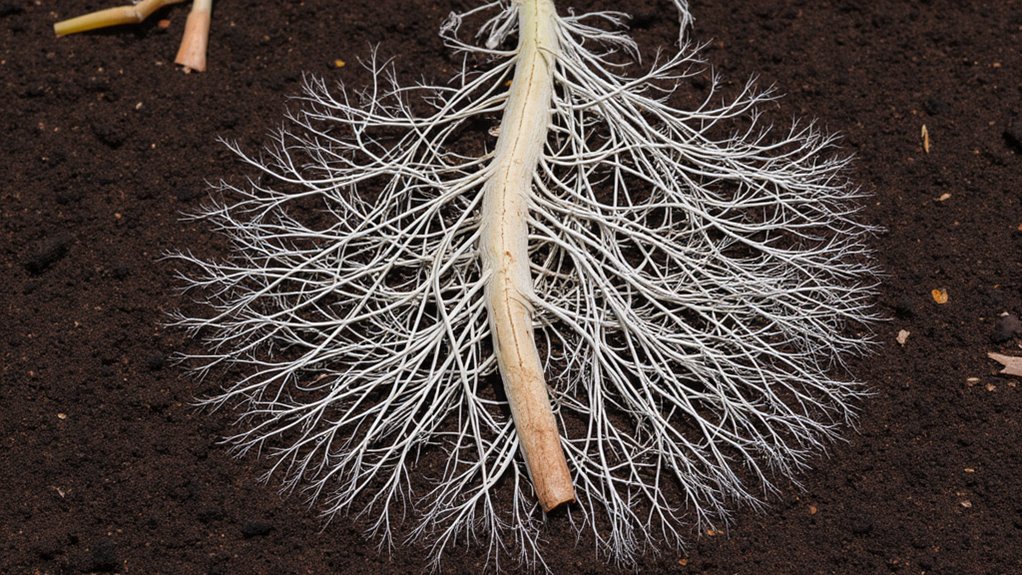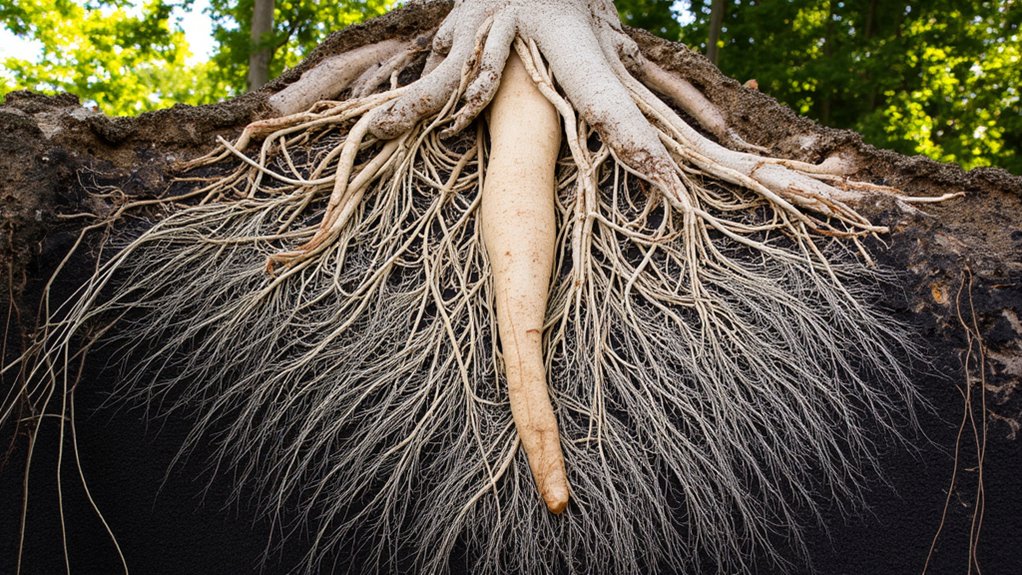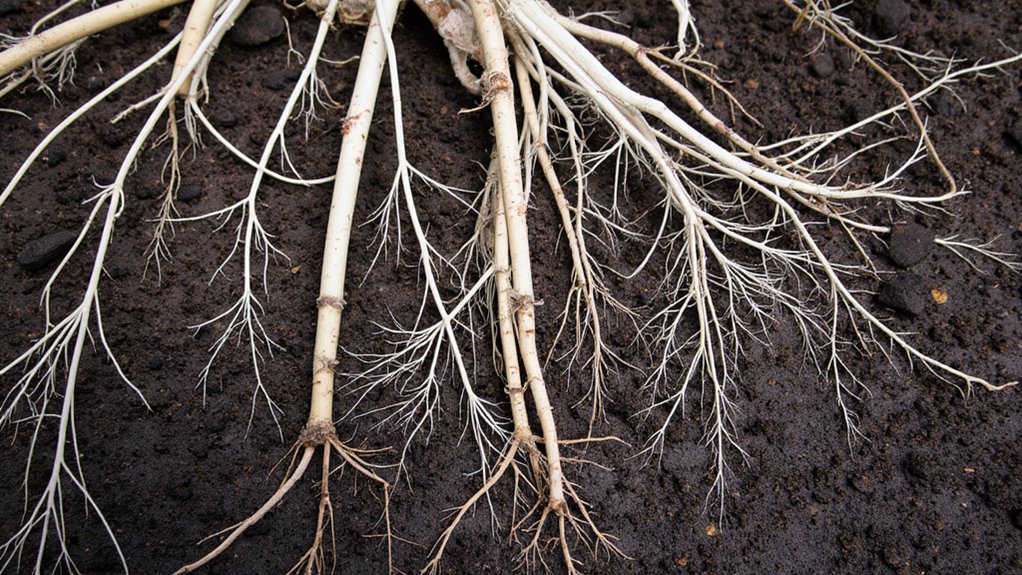You’ve probably noticed how some plants thrive effortlessly while others struggle, even in similar conditions. The secret often lies beneath the soil, where microscopic fungal networks called mycorrhizae form intricate partnerships with plant roots. These fungi, which connect to up to 90% of land plants, act like an underground Internet, sharing nutrients and water between neighboring plants. To understand how your garden can flourish, you’ll need to explore this hidden world of beneficial fungi.
Contents
- 1 What Are Mycorrhizal Fungi and How Do They Work?
- 2 The Ancient Partnership Between Plants and Fungi
- 3 Benefits of Mycorrhizal Networks for Plant Growth
- 4 Types of Mycorrhizal Associations in Nature
- 5 Supporting Healthy Fungal Communities in Your Garden
- 6 Common Signs of Strong Mycorrhizal Activity
- 7 Environmental Factors Affecting Fungal Development
- 8 Best Practices for Maintaining Soil Fungal Health
What Are Mycorrhizal Fungi and How Do They Work?

Nature’s hidden network of mycorrhizal fungi forms an intricate web beneath our feet, connecting plants in ways we’re only beginning to understand. These microscopic fungi create thread-like structures called hyphae, which attach to plant roots and extend up to 100 times farther than the roots themselves.
You’ll find two main types: ectomycorrhizae, which wrap around root surfaces, and endomycorrhizae, which penetrate root cells directly. They’re fundamentally nature’s nutrient delivery system, helping your plants access phosphorus, nitrogen, and water while getting sugars from plants in return. This symbiotic relationship boosts plant growth, disease resistance, and soil structure.
The Ancient Partnership Between Plants and Fungi

While dinosaurs roamed Earth millions of years ago, plants and fungi were already perfecting their underground alliance. You’ll find evidence of this partnership in 460-million-year-old plant fossils, showing that mycorrhizal relationships helped plants first colonize land.
Today, you can see this ancient connection continuing as fungi’s thread-like hyphae extend a plant’s reach by 100 times or more. These prehistoric partners evolved together, creating what scientists call a symbiosis. The fungi provide nutrients and water, while plants supply sugars from photosynthesis, a trade deal that’s worked for nearly half a billion years.
Benefits of Mycorrhizal Networks for Plant Growth

Because mycorrhizal networks connect multiple plants underground, they create a remarkable support system for growth and survival. You’ll find these fungi extending your plants’ reach for nutrients up to 50 times beyond their root zones, while also increasing water absorption by 20-40%.
Through these fungal networks, your plants can share resources. When one plant produces excess nutrients, it’ll transfer them to neighboring plants in need. You’ll see enhanced seedling survival rates, as established plants can nurture younger ones through the network. The fungi also help defend against pathogens by creating protective barriers around roots and releasing antimicrobial compounds.
Types of Mycorrhizal Associations in Nature
In plant-fungi partnerships, you’ll find two main categories of mycorrhizal associations: ectomycorrhizal and endomycorrhizal. While ectomycorrhizal fungi form a sheath around root cells, endomycorrhizal types actually penetrate inside them.
You’re most likely to encounter ectomycorrhizae in forest ecosystems, where they colonize about 2% of plant species, primarily trees. These fungi create visible white or colored networks around root tips.
Endomycorrhizae, particularly arbuscular mycorrhizal fungi (AMF), are far more common, associating with over 80% of land plants. They’re essential partners for most of your garden vegetables, grasses, and ornamental plants.
Supporting Healthy Fungal Communities in Your Garden
Once you understand how mycorrhizal networks function, you’ll see that supporting them isn’t complicated. Start by minimizing soil disturbance – avoid deep tilling and use mulch to protect the fungal networks beneath.
Add organic matter regularly through compost and leaf litter, which provides food for fungi. Don’t use synthetic fungicides or excessive fertilizers, as these disrupt the natural balance. Instead, maintain soil moisture at 40-60% capacity.
Plant diverse species with 2-3 feet spacing between larger plants, allowing fungal networks to develop. Include native plants, which often have established relationships with local mycorrhizal communities. For new gardens, consider adding mycorrhizal inoculants to jumpstart the process.
Common Signs of Strong Mycorrhizal Activity
A healthy mycorrhizal network displays several telltale indicators that you can spot in your garden. You’ll notice improved soil structure with crumbly, well-aggregated particles that hold together when squeezed. Plants will show vigorous growth and deeper color, especially in their leaves.
Look for strong, extensive root systems when you’re transplanting. You might see fine, white fungal threads, called hyphae, extending from the roots into the soil. Healthy mycorrhizal colonies also contribute to decreased water stress, so your plants won’t wilt as quickly during dry spells.
Your soil’s surface may develop a thin, whitish film in the early morning, indicating active fungal growth beneath.
Environmental Factors Affecting Fungal Development
Several key environmental conditions must align for mycorrhizal fungi to thrive in your garden’s ecosystem. You’ll need soil temperatures between 65-75°F, moderate moisture levels at 40-60% capacity, and pH ranging from 5.5 to 7.0.
Light conditions also play an essential role, as fungi prefer filtered sunlight or partial shade. Too much direct sun can dry out the soil network they’ve established, while dense shade limits their host plants’ photosynthesis.
Your soil’s organic matter content should stay above 3%, and you’ll want to avoid excessive tilling or compaction that disrupts the delicate fungal networks spreading through the soil profile.
Best Practices for Maintaining Soil Fungal Health
Whether you’re an experienced gardener or just starting out, maintaining healthy soil fungi requires consistent attention to basic cultivation practices. You’ll want to minimize soil disturbance, as excessive tilling can disrupt delicate fungal networks that take months to rebuild.
Keep your soil’s moisture level at 40-60% capacity, and add organic matter like composted leaves or aged manure twice yearly. Don’t use synthetic fungicides, which can harm beneficial fungi along with pathogens.
Plant cover crops, especially legumes and grasses, between growing seasons. They’ll help sustain your soil’s fungal communities and provide natural nutrients. Maintain soil pH between 6.0-7.0 for peak fungal growth.
